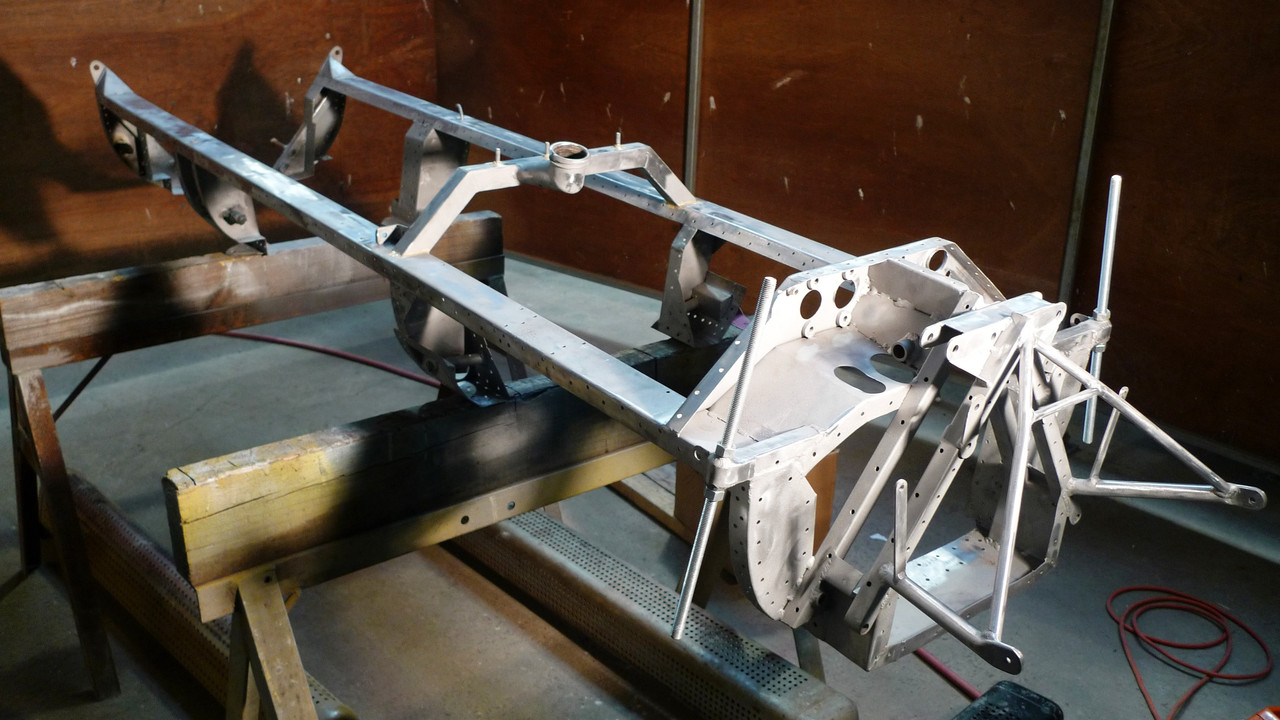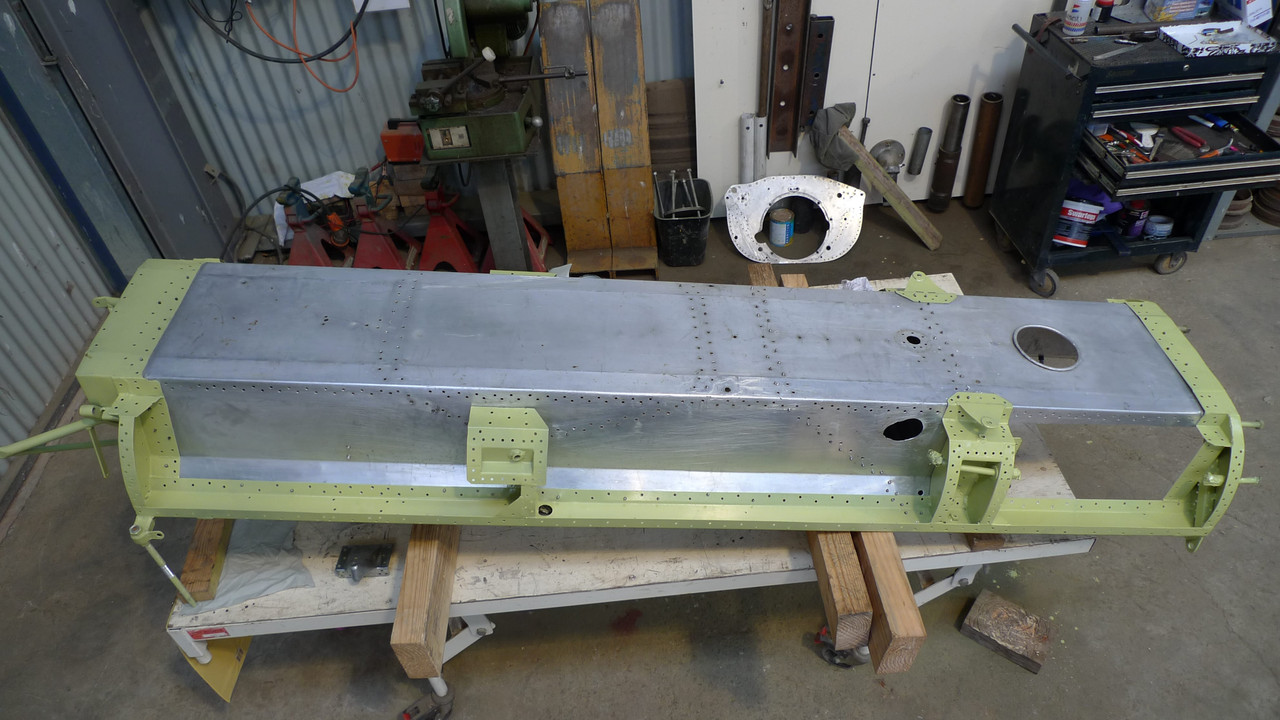Edited by SJ Lambert, 03 March 2014 - 22:27.

Integral Fuel Tank Sealant - want a friendly coating for 16 gauge steel to suit
#1

Posted 08 January 2014 - 11:54
Advertisement
#2

Posted 08 January 2014 - 22:19
Elfin may have used steel originally but the alloy is more practical. And alloy welding then was an art form, now any competent welder can buy the equipment and use it. Though I would get an experienced fabricator to weld it together
The old steel tanks I have seen [Elfin Clubbie] were soldered. Not good in an accident as it will split.
#3

Posted 08 January 2014 - 22:36
#4

Posted 09 January 2014 - 08:07
Our car has stood the test of time pretty well vis-a-vis the "included" steel sections of tankage that were painted. So we'd feel comfortable coating them with paint again if we can hit upon a paint type that will seal/bond well with the sealant & not adversely react to sealant or avgas.
Edited by SJ Lambert, 10 January 2014 - 11:54.
#5

Posted 09 January 2014 - 10:05
I would imagine some sort of epoxy paint but I'm no expert. There would have to be something used in aircraft somewhere.
You could always post some images so that we can see how an Elfin Mono was put together in the hope that it might attract some attention to your plight. (pretty please?)
#7

Posted 09 January 2014 - 11:31
Very good! The steel frame is nothing like what I imagined!
#8

Posted 09 January 2014 - 23:25
I'd talk to the aircraft restoration people if you can find any, or perhaps contact raychem and get some advice. I'm surprised 3M were useless as in my experience they were fun to work with and knowledgeable. Sorry, my contacts even if I could find them are 20 years out of date.
#9

Posted 10 January 2014 - 10:44
A very nice monocoque! - it is Matra - like. They were seen as a whole level above the UK fold and rivet guys when the first Matra F3 cars came out so it speaks well of Elfin's level of ambition.
May I suggest that age old standby for all plane builders/restorers - Aircraft spruce and Speciality.
http://www.aircraftspruce.com/
They have a huge variety of stuff and very good technical service plus they ship overseas.
Long before the Internet I loved geting their catalogue and browsed it for hours even though I had no inention of buying or building a plane.
#10

Posted 12 January 2014 - 23:04
#11

Posted 13 January 2014 - 23:26
You could find out what was used to seal the RAAF's F-111 tanks, effective, but toxic to absorb, personally - apparently.
Or check with some war-bird restoration guys, & find out what they do to replace to old, original self-sealing tank bladders.
Edited by JAW, 13 January 2014 - 23:28.
#12

Posted 14 January 2014 - 05:40
Did the F111 have painted steel riveted to alloy sheet and soaked in avgas?
#13

Posted 14 January 2014 - 06:05
Dunno the sophistications of the technicalities, F-111 tank sealing exactitude-wise,
avgas, avtur, rivets, composite-bonds, or what-have-you..
But I do know it was a problem-solving drama that has ongoing ramifications, even
after the machine has been retired..
That's why I suggested "...could find out..." - if it was of sufficient interest..
#14

Posted 14 January 2014 - 06:49
He has the sealer. He just wants the paint for the steel.
#15

Posted 14 January 2014 - 06:51
But is it compatible?
Do you know?
I ask, since having frustrating issues with commercial sealers for motorcycle fuel tanks
( failing, peeling & clogging fuel systems) I reverted to a true impervious metal-to-metal seal..
Edited by JAW, 14 January 2014 - 06:54.
#16

Posted 27 January 2014 - 10:04
Edited by SJ Lambert, 04 March 2014 - 08:50.
#17

Posted 27 January 2014 - 10:58
I thought it would be something epoxy.
It might be worth hitting up any aircraft repair place to see if they have a litre or two left over.
#19

Posted 04 May 2014 - 03:52
After all of that work, why not go a bit further and remove and strip the steel fuel tank panels. You can then epoxy coat and re-install them with a modern sealant material that will last decades. The sealant compounds used back when this chassis was originally built would not likely still be in good condition, and simply covering it with a fresh coat of paint will not help. Consider the potential problems resulting from pieces of the old sealant getting into the fuel system of your lovingly restored car.
Advertisement
#20

Posted 04 May 2014 - 07:10
There was an awful lot of slosh sealant along the vertical panel/tank space in this second shot. It's been completely removed though, so we should get a good seal second time around.
I may put up a few more restoration shots on the Elfin Monocoque thread when I get the chance - http://forums.autosp...-100-monocoque/


Edited by SJ Lambert, 04 May 2014 - 08:10.
#21

Posted 06 May 2014 - 04:40
Sorry, but apparently I misunderstood what materials the chassis is constructed of. To be clear, these are aluminum panels riveted to a welded steel tube frame, right? If so, you'll definitely want to make sure every faying surface between the aluminum and steel parts is thoroughly coated and sealed from moisture intrusion. The surfaces of all parts should be thoroughly cleaned and given a coat of epoxy primer. When installing the new rivets, the rivets should be "wet installed" with the same primer. After installing each panel, all of the joints and rivet heads should be sealed using something like a brushable polysulfide sealant compound. This will be good for 20 years+, even when exposed to gasoline.
Good luck with the project.
#22

Posted 27 June 2014 - 14:09
http://forums.autosp...-5#entry6763022
#24

Posted 09 April 2015 - 15:00
https://www.youtube....h?v=gkMzu_yH8B4
We'll see if we can get over to Adelaide in a couple of weeks for the Historic Mallala meeting.
Wheel alignment scheduled for tomorrow........















